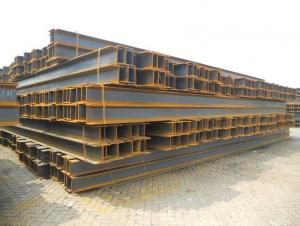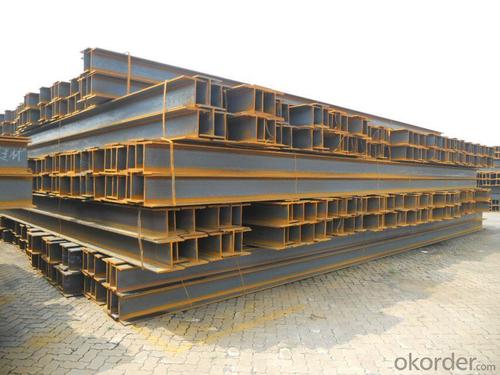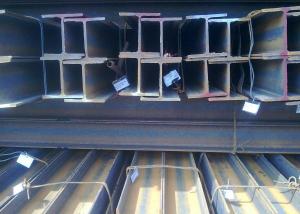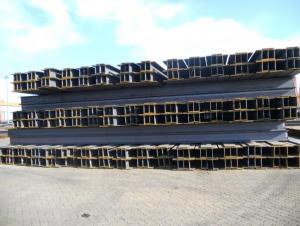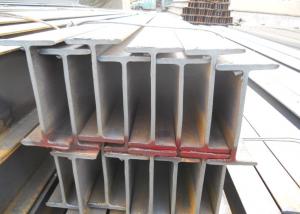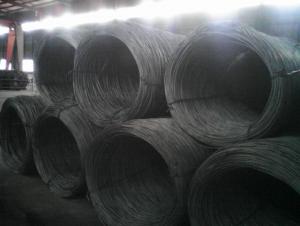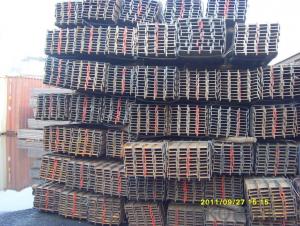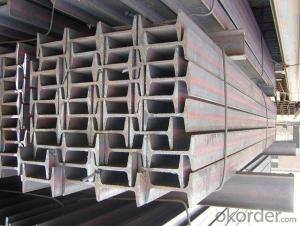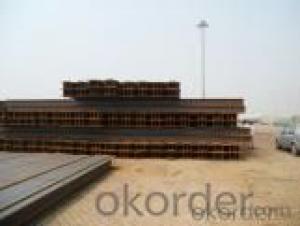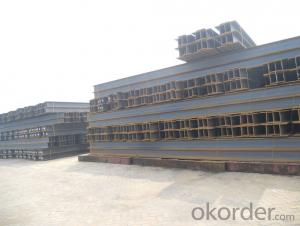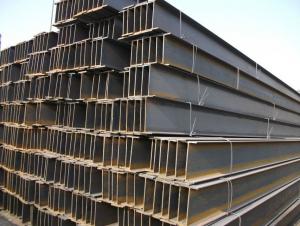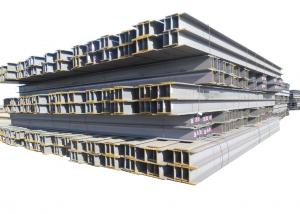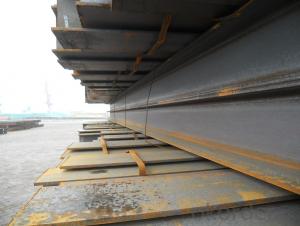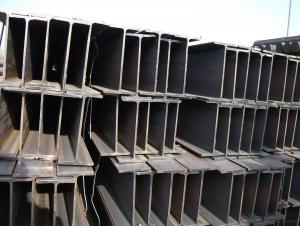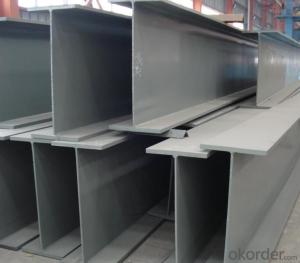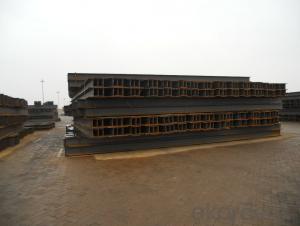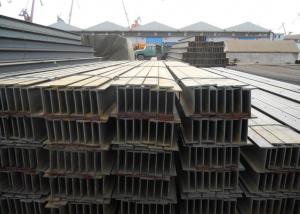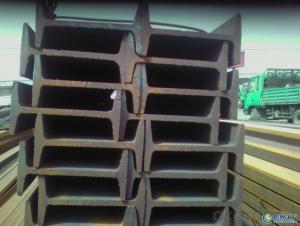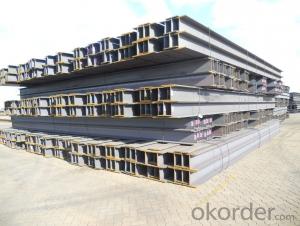Hot Rolled Structural Steel H Beam JIS 3192
- Loading Port:
- Tianjin
- Payment Terms:
- TT or LC
- Min Order Qty:
- 25 m.t.
- Supply Capability:
- 100000 m.t./month
OKorder Service Pledge
OKorder Financial Service
You Might Also Like
Product Description:
OKorder is offering Hot Rolled Structural Steel H Beam JIS 3192 at great prices with worldwide shipping. Our supplier is a world-class manufacturer of steel, with our products utilized the world over. OKorder annually supplies products to European, North American and Asian markets. We provide quotations within 24 hours of receiving an inquiry and guarantee competitive prices.
Product Applications:
Hot Rolled Structural Steel H Beam JIS 3192 are ideal for structural applications and are widely used in the construction of buildings and bridges, and the manufacturing, petrochemical, and transportation industries.
Product Advantages:
OKorder's Hot Rolled Structural Steel H Beam JIS 3192 are durable, strong, and resist corrosion.
Main Product Features:
· Premium quality
· Prompt delivery & seaworthy packing (30 days after receiving deposit)
· Corrosion resistance
· Can be recycled and reused
· Mill test certification
· Professional Service
· Competitive pricing
Product Description:
Specifications of Hot Rolled Structural Steel H Beam JIS 3192
1. Standard: GB700-88, Q235B2.
2. Grade: Q235, SS400 or Equivalent
3. Length: 6m,10m, 12m as following table
4. Invoicing on theoretical weight or actual weight as customer request
5.Payment: TT or L/C
Usage & Applications of Hot Rolled Structural Steel H Beam
Commercial building structure ;Pre-engineered buildings; Machinery support structure; Prefabricated structure; Medium scale bridges; Ship-building structure. etc.
Packaging & Delivery of Hot Rolled Structural Steel H Beam
1. Packing: it is nude packed in bundles by steel wire rod
2. Bundle weight: not more than 3.5MT for bulk vessel; less than 3 MT for container load
3. Marks:
Color marking: There will be color marking on both end of the bundle for the cargo delivered by bulk vessel. That makes it easily to distinguish at the destination port.
Tag mark: there will be tag mark tied up on the bundles. The information usually including supplier logo and name, product name, made in China, shipping marks and other information request by the customer.
If loading by container the marking is not needed, but we will prepare it as customer request.
4. Transportation: the goods are delivered by truck from mill to loading port, the maximum quantity can be loaded is around 40MTs by each truck. If the order quantity cannot reach the full truck loaded, the transportation cost per ton will be little higher than full load.
5. Delivered by container or bulk vessel
Production flow of Hot Rolled Structural Steel H Beam
Material prepare (billet) —heat up—rough rolling—precision rolling—cooling—packing—storage and transportation
FAQ:
Q1: Why buy Materials & Equipment from OKorder.com?
A1: All products offered byOKorder.com are carefully selected from China's most reliable manufacturing enterprises. Through its ISO certifications, OKorder.com adheres to the highest standards and a commitment to supply chain safety and customer satisfaction.
Q2: Can fit in the containers of 20fts the steel beams of 6M?
A2: No proble, we can put them into the containers in the form sideling.
Q3: The products are invoicing on theoritical weight or on actual weight?
A3: We can do it in both manners, according to the customers' request.
Images:
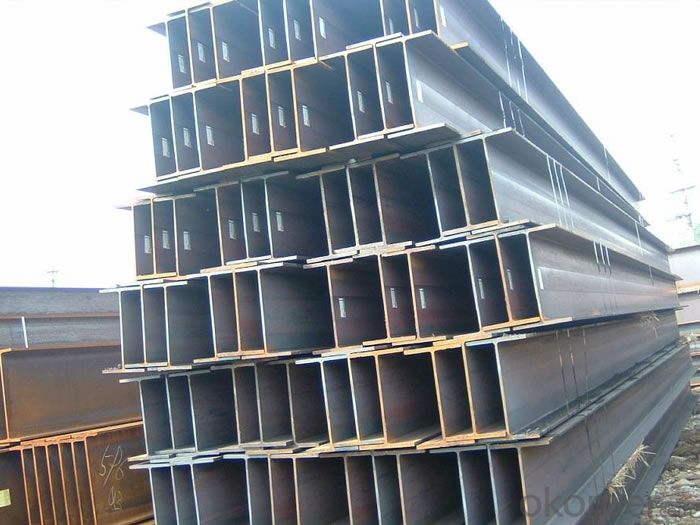
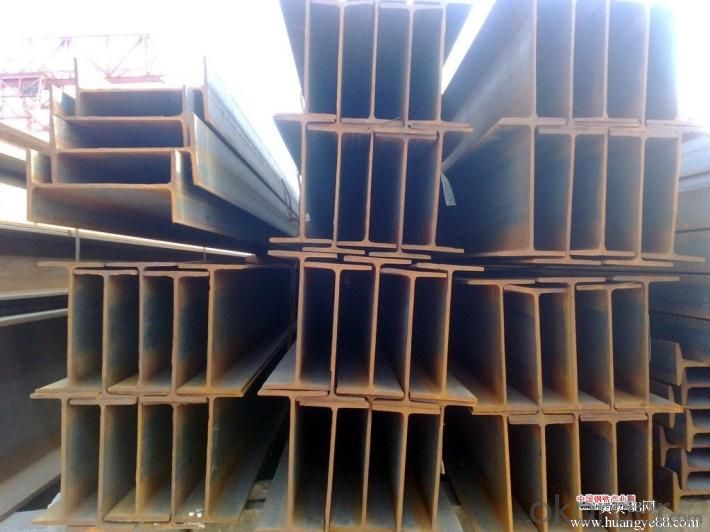
- Q: Are there any limitations or restrictions in using Steel H-Beams in construction?
- Indeed, there are various constraints and regulations to take into account when employing Steel H-Beams in construction. Some of these limitations encompass the following: 1. Size and weight restrictions: Steel H-Beams are available in diverse sizes and weights, and there might be restrictions on the maximum dimensions or mass that can be employed in a given building venture. Typically, this determination is made by the structural engineer who factors in elements such as load-bearing capacity, deflection limits, and overall design requisites. 2. Cost: Comparatively, Steel H-Beams can be pricier than alternative construction materials like wood or concrete. Consequently, this financial aspect may impede their use in projects constrained by budget or prioritizing cost optimization. 3. Availability: The availability of Steel H-Beams may be limited in certain regions, particularly in remote areas where transportation expenses can be prohibitive. This scarcity might necessitate the utilization of alternative materials or different construction methodologies. 4. Design limitations: Steel H-Beams necessitate specific design prerequisites to guarantee structural integrity. These requirements include appropriate connections, bracing, and adequate spacing. Failure to meet these design specifications can result in a weakened structure or compromised safety. 5. Fire resistance: Steel possesses limited inherent fire resistance and can lose its strength when exposed to high temperatures. Therefore, when employing Steel H-Beams in construction, especially in buildings subject to specific fire safety regulations, additional fire protection measures such as fire-resistant coatings or insulation need to be considered. 6. Environmental considerations: The production of steel carries a significant environmental impact due to the carbon emissions associated with its manufacturing process. In certain instances, there may be restrictions or limitations on the utilization of steel in construction projects that prioritize sustainability or adhere to specific environmental regulations. To ensure that the limitations and restrictions of employing Steel H-Beams are appropriately considered and addressed in any construction project, it is imperative to consult with a structural engineer and adhere to local building codes and regulations.
- Q: Can steel H-beams be used in museum storage or archive facilities?
- Yes, steel H-beams can be used in museum storage or archive facilities. Steel H-beams are commonly used in construction for their strength and durability. They provide excellent support and can withstand heavy loads, making them suitable for storing and organizing various items in museum storage or archive facilities. Additionally, steel H-beams can be easily customized and adjusted to meet specific storage requirements, making them a versatile option for these types of facilities. Furthermore, steel is resistant to pests, fire, and moisture, which are important considerations when preserving valuable artifacts or documents. Overall, steel H-beams are a reliable and practical choice for museum storage or archive facilities.
- Q: What is the purpose of using H-beams?
- H-beams, also known as I-beams or universal beams, have a crucial role in the construction industry. They serve to provide structural support and strength to different types of structures, including buildings, bridges, and other infrastructure projects. The distinctive shape of H-beams, resembling the letter "H" when viewed from the cross-section, is one of their key advantages. This design enables H-beams to distribute weight evenly and effectively, making them ideal for carrying heavy loads and resisting bending or deflection. The top and bottom flanges of the beam offer resistance against compressive and tensile forces, while the web in between ensures stability and prevents buckling. The purpose of using H-beams is to establish a stable and durable framework for various structures, ensuring their longevity and safety. They are frequently used in the construction of high-rise buildings, as they can support significant vertical loads, such as the weight of multiple floors, walls, and equipment. In bridge construction, H-beams are commonly utilized due to their strength and load-bearing capacity being crucial. Engineers can design bridges capable of withstanding heavy traffic loads and environmental forces by employing H-beams, thereby ensuring the safety and functionality of these critical transportation structures. Furthermore, H-beams find applications in industrial structures, such as warehouses and factories, where they provide necessary support for heavy machinery, cranes, and storage systems. The robustness and stability of H-beams make them an excellent choice for such applications, guaranteeing the integrity and functionality of the structures. In summary, the purpose behind using H-beams is to provide structural support and strength to various construction projects, including buildings, bridges, and industrial structures. Their unique shape and design allow for efficient weight distribution, resistance against bending, and overall stability. As a result, they have become an indispensable component in modern construction practices.
- Q: How do steel H-beams compare to timber beams?
- Steel H-beams and timber beams have their own unique advantages and disadvantages, making them suitable for different applications. Steel H-beams are known for their high strength and durability. They can support heavy loads and are resistant to bending and warping. This makes them ideal for constructing large structures and buildings that require significant load-bearing capacity. Additionally, steel H-beams have a longer lifespan compared to timber beams as they are not susceptible to rot, termites, or other types of decay. They are also fire-resistant, making them a safer option in case of a fire. On the other hand, timber beams have their own merits. They are generally more cost-effective compared to steel H-beams, especially when considering the initial investment and installation costs. Timber beams are also lighter and easier to handle, making them more convenient for small-scale construction projects or in situations where weight is a concern. Additionally, timber beams have natural thermal insulation properties, making them energy-efficient and suitable for environmentally conscious designs. Ultimately, the choice between steel H-beams and timber beams depends on factors such as the intended use, load requirements, budget constraints, and personal preferences. Proper evaluation of these factors will help determine which type of beam is the most suitable for a specific construction project.
- Q: What does H steel column H300*250*6*10-90 represent in steel structure?
- Steel column: a column made of steel. Large and medium-sized industrial buildings (see map [CFST column construction plant "), long-span public buildings, high-rise buildings, homes, light work platform, the Zhanqiao and the support column, most of the steel column. The classified steel column can be divided into solid column and lattice column (Figure 1[steel column) in the form of cross section. Section form solid column with steel column section [the whole), is the most commonly used I-section; lattice column section is divided into two limbs or more limbs, the limbs with batten or batten plate contact (Figure 2b[] section steel column), when the load is larger than m, when the width of steel consumption is saved.
- Q: What is the cost of steel H-beams?
- The cost of steel H-beams can vary depending on various factors such as the size, grade, and supplier. It is recommended to contact local steel suppliers or check online marketplaces for accurate and up-to-date prices.
- Q: Can steel H-beams be used for mezzanine storage systems?
- Indeed, mezzanine storage systems can employ steel H-beams. These systems aim to maximize space within industrial facilities or warehouses by utilizing the vertical height of the structure. Due to their robustness, longevity, and capacity to bear substantial loads, steel H-beams are typically employed as the principal structural element in mezzanine systems. The H-beams are commonly fastened together to create a stable framework capable of supporting the weight of the mezzanine floor and stored items. Moreover, steel H-beams can be effortlessly customized and adjusted to meet the specific requirements of the mezzanine system, rendering them a fitting choice for such applications.
- Q: Can Steel H-Beams be used in school or educational building construction?
- Yes, steel H-beams can be used in school or educational building construction. Steel H-beams are commonly used in construction due to their strength, durability, and versatility. They can provide structural support for large spans and heavy loads, making them suitable for constructing school buildings that require open and flexible spaces for classrooms, auditoriums, and other educational facilities. Additionally, steel H-beams are fire-resistant, which is a crucial safety consideration in educational buildings.
- Q: How do steel H-beams perform in extreme temperatures?
- Steel H-beams perform well in extreme temperatures due to their high thermal conductivity and low thermal expansion coefficient. This means that they can effectively dissipate heat and resist deformation caused by thermal expansion and contraction. Additionally, steel has a high melting point, making it suitable for use in extreme temperature conditions. However, it is important to note that prolonged exposure to extremely high temperatures can eventually weaken the steel, causing it to lose some of its structural integrity. Therefore, it is crucial to consider the specific temperature range and duration when evaluating the performance of steel H-beams in extreme temperatures.
- Q: Can steel H-beams be used in residential deck or patio structures?
- Yes, steel H-beams can be used in residential deck or patio structures. Steel H-beams provide strong structural support and are commonly used in construction projects, including residential applications. They offer durability and stability, making them a suitable choice for deck or patio structures.
Send your message to us
Hot Rolled Structural Steel H Beam JIS 3192
- Loading Port:
- Tianjin
- Payment Terms:
- TT or LC
- Min Order Qty:
- 25 m.t.
- Supply Capability:
- 100000 m.t./month
OKorder Service Pledge
OKorder Financial Service
Similar products
Hot products
Hot Searches
Related keywords
